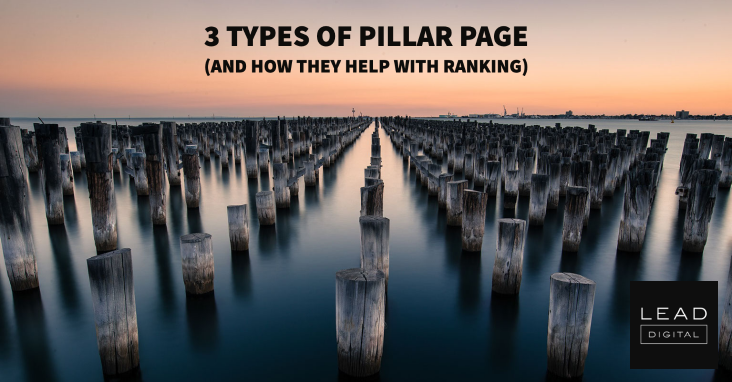
What Is a Pillar Page?
In effect, a pillar page is a hub or basis on which the cluster pages are built. It provides a comprehensive overview of a topic but leaves room for more detailed coverage of the topic in the cluster pages, which typically focus on a particular aspect of the topic, often a keyword.
For example, a pillar content page on SEO might briefly touch on technical SEO and then link to a cluster page that goes far more in-depth on the topic.
Pillar pages are often longer than typical blog posts (usually 2,000 words or more) because they touch on all parts of a topic. Pillar and cluster pages link back to each other, but if the pillar page design does its job right, it becomes an authoritative source that attracts many external links.
The Benefits of Pillar and Cluster Pages Include:
- Increased engagement: Well-organized content makes it very user-friendly for viewers, driving up engagement.
- Longer session durations: Because the pillar-cluster pages are interlinked, this arrangement tends to keep visitors on the site longer, driving up engagement and page views.
- Provide better signals to Google: Because pillar and cluster page groupings are so well organized, it is easy for Google to determine their subject matter and rank them. Badly organized webpages tend to be poorly ranked by Google, so content organized by topic pillars and clusters tends to get rewarded with higher rankings.
Comprehensive pillar pages are one of the most effective ways to create content that appeals to search engine algorithms and targets audiences with authoritative information.
Next, we will explain some of the main types of content pillar pages. Keep in mind that the divisions between these categories are not absolute, so some pillar pages might have elements of each.
1. The “Guide” Pillar Page
As its name suggests, a “guide” pillar page strives to be the ultimate authority on a subject. It could be a 101 guide for beginners or something more sophisticated aimed at a specific industry segment. A guide or an “ultimate guide” serves to establish your authority in a field or subject matter, builds your brand, and helps establish trust with a particular audience.
The guide pillar page gives a comprehensive overview of a topic that makes it an authoritative destination for those interested in the subject. It also links to related cluster pages that expand knowledge on particular aspects of the topic, often related to a specific keyword.
A timely and well-conceived guide pillar page can garner a lot of attention, boost website traffic, attract backlinks, and nurture an audience who can be converted into subscribers or paying customers.
Some good “guide” pillar page examples include:
The Ultimate Guide to Remote Meetings in 2020
A strong topic for pillar pages tends to be evergreen, and one example is remote work. Slack decided to create a useful guide for its users with “The Ultimate Guide to Remote Meetings.”
There is a lot on this page that makes it a great pillar, particularly when understanding what the reader can expect and the navigation. At the top of the page, there is a note about how long it will take the reader to get through the content and a few bullets that emphasize best practices for remote meetings.
There are also a lot of interactive elements throughout the piece to help keep the reader engaged. For instance, the floating navigation bar allows the reader to quickly jump from one section to the next. The page includes a video that shows a remote meeting in action.
Slack’s internal linking strategy for the pillar page directs readers to topic clusters that include more tips for remote work and specific benefits to using Slack.
Brand Awareness: Nearly Everything You Need to Know
Typeform is a Barcelona-based online software as a service (SaaS) company specializing in online form building and online surveys. It also has a series of well-designed, visually attractive pillar pages devoted to brand awareness, like this one.
A navigation menu off to the side makes it easy to navigate the long scrolling page of information on brand awareness basics — tracking your brand awareness, kick-starting your brand awareness, and measuring your brand awareness — and offers some parting words of advice.
The page has many links to related resources, including external and more internal links toward the end of the page.
Typeform’s internal linking strategy for this pillar page links to other resources in their blog and pages with their service offerings — specifically templates that potential customers can use.
2. The “What Is” Pillar Page
A very typical query made by people is, “What is …” They hear about something interesting, controversial, or timely and want to learn more.
- “What is programmatic advertising?”
- “What is herd immunity?”
- “What is Kubernetes?”
To tap into this desire to learn more, a pillar page can serve as a definitive examination of a subject — a highly useful stand-alone resource that links to related cluster pages and develops aspects of the subject in greater detail. In many ways, it is authoritative, like a guide page.
If you develop a page that matches a widespread interest (“I have heard something about this a couple of times and want to learn more,” or “I have always wanted to know more about this”) and build a case for its importance, you have created a great way to drive organic traffic to your site. The traffic becomes a top-of-the-funnel flow that eventually can be won over as valued customers with the right conversion strategy.
Here are a couple of examples of “what is” pillar pages that do their jobs: – Read more



